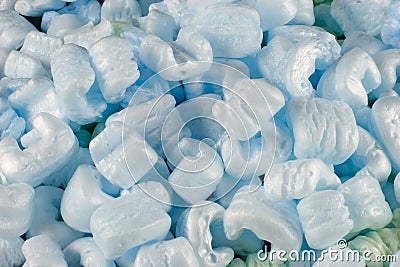- When Styrofoam packing peanuts are immersed in acetone (the primary component in some nail-polish removers), they dissolve. If the acetone is allowed to evaporate, a solid remains.The solid still consists of Styrofoam, but now it is solid and much denser. Explain.Hint:Remember that Styrofoam is made with foaming agents.

https://www.dreamstime.com/royalty-free-stock-photography-packing-peanuts-alpha-image1462207
Acetone dissolves the polymer, allowing the gas of the foaming agent to escape. The polymer collapses on itself and is more dense because the gas has been removed. - Consider Spectra, Allied-Signal Corporation’s HDPE fiber, used as liners for surgical gloves.Although the Spectra liner has a very high resistance to being cut, the polymer allows a surgeon to maintain a delicate sense of touch. The interesting thing is that Spectra is linear HDPE, which is usually associated with being rigid and not very flexible.
 http://www.kruuse.com/en/News/2012/03/21/~/media/Images/Catalogue/260951_260957_1.ashx
http://www.kruuse.com/en/News/2012/03/21/~/media/Images/Catalogue/260951_260957_1.ashx
a. Suggest a reason why branched LDPE cannot be used in this application.
LDPE cannot be used in this application because it does not have the required strength.
b.Offer a molecular level reason for why linear HDPE is successful in this application.
The molecules of HDPE must line up in a way that produces the required strength. Using a thin liner of HDPE allows sufficient flexibility.c. What is the difference in the material used in “hard” and “soft” contact lenses? How do the differences in properties affect the ease of wearing of contact lenses?
As mentioned in the previous part, hard contact lenses are typically made of PMMA, a rigid non-gas permeable plastic. The soft contact lenses that replaced them are made of silicone, which is flexible and allows oxygen to reach the eye. Because of these properties,the soft lenses tend to be more comfortable
- When you try to stretch a piece of plastic bag, the length of the piece of plastic being pulled increases dramatically and the thickness decreases. Does the same thing happen when you pull on a piece of paper? Why or why not? Explain on a molecular level.
When the piece of plastic is stretched, the strip narrows and “necks down.” The molecules become aligned parallel to each other and in the direction of the pull. This alteration of the three-dimensional structure is not reversible, and if the pulling continues, the plastic breaks.When the same pulling force is applied to a piece of paper, the paper tears rather than stretching to any significant extent. The cellulose molecules in paper are held far more rigidly in place, and are not free to become aligned. - A Teflon ear bone, fallopian tube, or heart valve? A Gore-Tex implant for the face or to repair a hernia? Some polymers are biocompatible and now used to replace or repair body parts. a. List four properties that would be desirable for polymers used within the human body.
The benefits for polymers intended for use in the body should far outweigh any risks. The two main properties are (1) stable over time of intended use and (2) non-toxic. Other factors to consider are low cost, lack of solubility in body fluids, lack of reactivity in body fluids,and the ease of implantation.b. Other polymers may be used outside your body, but in close contact with it. For example,no surgeon is needed for you to use your contact lenses—you insert, remove, clean, and store them yourself. From which polymers are contact lenses made? What properties are desirable in these materials? Either a call to an optometrist or a search on the Web may provide some answers.
Several different types of contact lenses are on the market and each uses a different type of polymer. Polymethyl methacrylate (PMMA), one of the earliest polymers used for rigid gas permeable lenses, is structurally similar to Lucite and plexiglas. Silicone-acrylate materials now are more commonly used under trade names such as Kolfocon. Newer rigid gas permeable (RGP) polymers contain fluorine: fluoro-silicone-acrylate polymers and fluoro-silicones. Polymacon (38% water) is typical of the polymers used for soft lenses and is a polymer of 2-hydroxyethyl methacrylate (HEMA). Other methacrylates include hioxifilcon(48% water) and methafilcon (55% water) or even lidofilcon (70% water). Manufacturers’ websites are good sources of information.Desirable properties include being nontoxic, permeable to oxygen, comfortable to wear, and inexpensive. Also desirable is the ability to conform to the shape of the eye and to be easily cleaned (if not disposable).
Month: March 2017
Why is it important? – Biofuel
Biofuel vs Fossil Fuel
Application Exercise 6: Neutralising the Threat of Acid Rain
- Mammoth Cave National Park in Kentucky is in close proximity to the coal-fired electric utility plants in the Ohio Valley. Noting this, the National Parks Conservation Association(NPCA) reported that this national park had the poorest visibility of any in the country.
 a. What is the connection between coal-fired plants and poor visibility?
a. What is the connection between coal-fired plants and poor visibility?
Sulfur dioxide are release from the coal-fired plants, creating sulfate particles responsible for 60% to 80% of the poor visibility in eastern parks.
b. The NPCA reported “the average rainfall in Mammoth Cave National Park is 10 times more acidic than natural.” From this information and that in your text, estimate the pH of rainfall in the park.
Normal rain has a pH range of 5–6, so if the rainfall in this park is 10 times more acidic,the pH range must be 4–5.
2. Here are examples of what an individual might do to reduce acid rain.
For each, explain the connection to producing acid rain.
a. Hang your laundry to dry it.

http://imagecache2.allposters.com/images/STFPOD/859022.jpg
Hanging laundry to dry requires less energy as compared to using a clothes dryer. An electric dryer required power that are produced by companies through the burning of coal.
b. Walk, bike, or take public transportation to work.
By walking or taking a bike, we are not burning any energy sources such as coal and gasoline that will contribute to acid rain. Public transportation is better than driving individually as it reduces the amount of gasoline used hence reducing emission. Therefore, contributing less to the acidity of rain.
c. Avoid running dishwashers and washing machines with small loads.
Maximum energy efficiency. Dishwashers and washing machines are powered by companies by burning coal which contribute to the increase acidity of rain.
d. Add additional insulation on hot water heaters and pipes.
Insulating hot water heaters and pipes can reduce heat loss and raise water temperature. Therefore, less coal is needed to be burn to power the above appliances, hence reducing acid rain.
e. Buy locally grown produce and locally produced food.

http://d22ir9aoo7cbf6.cloudfront.net/wp-content/uploads/sites/2/2015/06/Farm-Hero.jpg
Food miles refer to distance a food item had travel from farm to household. Therefore, to conserve energy and reduce global climate change, we should buy more locally grown and produced food. A tremendous amount of fuel are used to transport food long distances. The combustion of fuels will release carbon dioxide, sulfur dioxide, particulate matter and other pollutants into atmosphere, contributing to climate change, acid rain and air pollution. Refrigeration are also required to keep products fresh resulting in more coal used to power it.
3a. Give names and chemical formula for five acid and five bases.
Acid
– Hydrochloric acid: HCI
– Carbonic acid: H2CO3
– Nitric acid: HNO3
– Sulfuric acid: H2SO4
– Sulfurous acid: H2SO3
Bases
– Sodium hydroxide: NaOH
– Potassium hydroxide: KOH
– Calcium hydroxide: Ca(OH)2
– Ammonium hydroxide: NH4OH
– Methyl amine: CH3NH2
3b. Name three observable properties generally associated with acids and bases.
Acids
– The word acid derived from Latin word acere, France word acide & Germany word säure which
means sour. All acids taste sour such as vinegar and lemon juice.
– Acids make litmus (a blue vegetable dye) turn red.
– Acids destroy chemical properties of bases.
Bases
– All bases taste bitter. Mustard and most medicines are bases.
– Bases will restore the original blue colour of litmus after reddened by an acid.
– Bases destroy chemical properties of acids.
4. The concerns of acid rain vary across the globe. Many countries in North America and Europe have websites dealing with acid rain. Either search to locate one (“Canada, acid rain”) or use these links to websites in Canada, the UK, or Europe. What are the issues in Singapore? Does the acid deposition originate outside or inside the Singapore’s borders?

According to Environment and Climate Change Canada (https://www.ec.gc.ca/air/default.asp?lang=En&n=AA1521C2-1), acid deposition is a general term that includes more than simply acid rain. Acid deposition is primarily the result of emissions of sulphur dioxide (SO2) and nitrogen oxides (NOx) that can be transformed into dry or moist secondary pollutants such as sulphuric acid (H2SO4), ammonium nitrate (NH4NO3) and nitric acid (HNO3) as they are transported in the atmosphere over distances of hundreds to thousands of kilometres.
Acidic particles and vapours are deposited in two processes – wet and dry deposition. Wet deposition is acid rain, the process by which acids with a pH normally below 5.6 are removed from the atmosphere in rain, snow, sleet or hail. Dry deposition takes place when particles such as fly ash, sulphates, nitrates, and gases (such as SO2 and NOx), are deposited on, or absorbed onto, surfaces. The gases can then be converted into acids when they contact water.
A research was conducted by Balasubramanian, R.; Victor, T.; Begum, R., Tittle: Impact of biomass burning on rainwater acidity and composition in Singapore, in 1999.
http://scholarbank.nus.edu.sg/handle/10635/92044
The research look into the impact of the Indonesian forest fires that took place from August through October 1997. Large amounts of gaseous and particulate pollutants were released into the atmosphere. The particulate emissions produced a plume that was easily visible by satellite and significantly affected regional air quality in Southeast Asia. The prolonged haze episode provided an unprecedented opportunity to examine the effects of biomass burning on regional atmospheric chemistry. The researchers undertook a comprehensive field study to assess the influence of biomass burning impacted air masses on precipitation chemistry in Singapore. Major inorganic and organic ions were determined in 104 rain samples collected using an automated wet-only sampler from July through December 1997. Mean pH values ranged from 3.79 to 6.20 with a volume-weighted mean of 4.35. There was a substantially large number of rain events with elevated concentrations of these ions during the biomass burning period. The relatively high concentrations of SO4 2-, NO3 -, and NH4 + observed during the burning period are attributed to a long residence time of air masses, leading to progressive gas to particle conversion of biomass burning emission components. The decrease in pH of precipitation in response to the increased concentrations of acids is only marginal, which is ascribed to neutralization of acidity by NH3 and CaCO3.
Biofuels
Carbon Fixation
The process of taking an inorganic compound e.g. Carbon Dioxide to organic compounds. If it happens in a living organism its called biological carbon fixaton.
Biofuel
A hydrocarbon by or from a living organism that humans can use to power something e.g. cars or any hydrocarbon produced by or from a living organism in a short period of time.
Biomass
Organic matter, dead material that was once living e.g. kernel of corn sugar cane etc. It is used to make biofuels and this makes biofuel more renewable as biomass can be reproduced in a short time.
Examples of biofuel vs its fossil fuel counterparts
| Biofuel | Fossil Fuel | Differences |
| Ethanol | Ethane/ Gasoline | Ethanol burns cleaner than gasoline but it only has half the energy per unit mass of gasoline. Thus it produces less carbon monoxide but more ozone which contributes substantially to smog |
| Biodiesel | Diesel | Burns cleaner than diesel, produce less particulate and fewer sulfur compounds. However, it is corrosive to the engine thus modifications have to be done for the engine to take biodiesel. Has only slightly less energy per unit mass than diesel |
| Methanol | Methane | Easier to transport as compared to methane as it’s in the liquid form. Only has one third to half as much energy per unit mass as methane. |
| Biobutanol | Butane/ Gasoline | Can run in any car that uses gasoline, contains almost the same energy per unit mass as gasoline |

Alcohols contain very little or no sulfur thus combustion of alcohol produces very little sulfur dioxide and sulfuric acid. However, alcohols are derived from plant and animal matter thus containing a lot of nitrogen. This is bad as it will produce a lot of nitric oxides and other nitrogenous compounds which contributes to acid rain in the long run
However, burning alcohols and biodiesel produces less carbon monoxide as compared to petrol diesel.
Production of biofuels from biomass
Biofuel: Ethanol
Biomass: sugar cane, corn, wheat, sugar beets, industrial sweet potatoes

Method of production: Biochemical Conversion
Enzymes and microorganisms Catalyse the conversion of biomass or biomass-derived compounds into desirable products. Enzymes such as Cellulase break down the carbohydrate fractions of biomass to five- and six-carbon sugars via hydrolysis, Yeast and bacteria then ferment the sugars into products
https://energy.gov/eere/energybasics/articles/biofuel-conversion-basics
http://www.eesi.org/topics/bioenergy-biofuels-biomass/description
